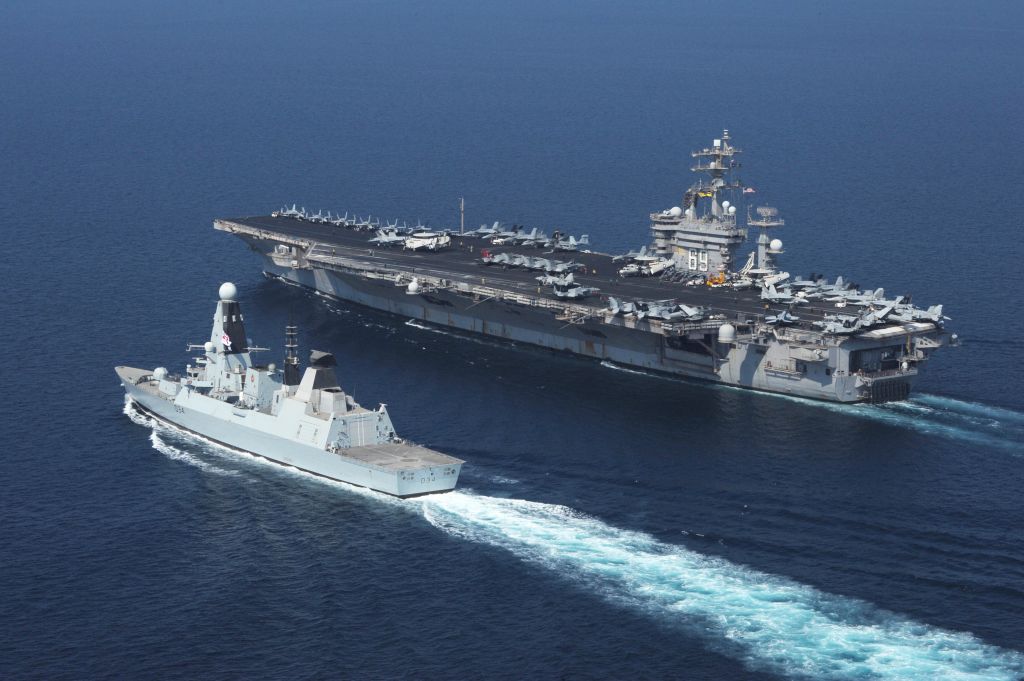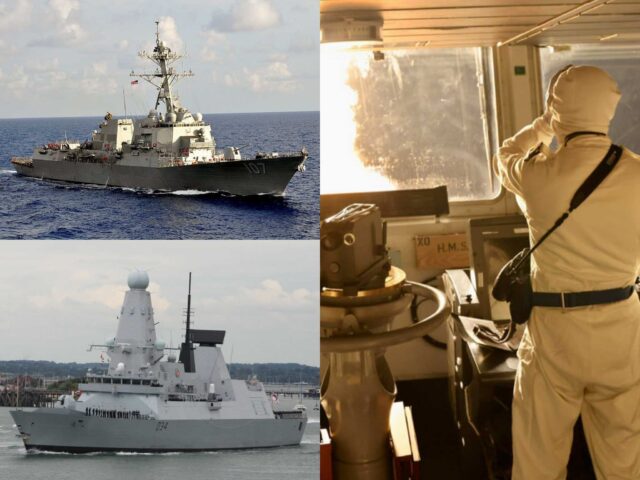U.S. and British warships and aircraft shot down “the largest attack from the Iranian-backed Houthis in the Red Sea to date” overnight, taking down every drone, cruise missile, and ballistic missile, preventing damage to warships and merchant shipping.
Eighteen ‘suicide attack’ drones, two anti-ship cruise missiles, and one anti-ship ballistic missile were launched by Iran-backed Shiite Houthi fighters in Yemen towards the Red Sea overnight on the 9th of January, part of an ongoing effort to attack the economy of Western nations by destroying merchant ships and closing the crucial Red Sea route to trade.
The 21 drones and missiles shot down by the United States Navy (USN) and Royal Navy (RN) on Tuesday night is greater than the 19 Operation Prosperity Guardian has otherwise shot down in the entire operation to date, according to numbers stated by a USN Admiral last week.
U.S. Central Command (CENTCOM) said the attempted strike was a “complex attack of Iranian designed one-way attack [drones]” and missiles launched towards “international shipping lanes where dozens of merchant vessels were transiting”. The aircraft carrier USS Dwight D. Eisenhower and F-18s from its airwing, and the destroyers USS Gravely, USS Laboon, USS Mason, and HMS Diamond were involved in the defensive effort.
Overnight, the largest Houthi attack to date in the Red Sea was successfully repelled by @hmsdiamond and US warships.
Deploying Sea Viper missiles and guns, HMS Diamond destroyed multiple attack drones heading for her & commercial shipping in the area.@DefenceHQ @RoyalNavy pic.twitter.com/NWgvYyNgC8
— Defence Operations (@DefenceOps) January 10, 2024

Royal Navy destroyer HMS Diamond alongside aircraft carrier Dwight D Eisenhower, two of the ships involved in Tuesday night’s action, in a file photo from November 4, 2012. Image courtesy Ryan D McLearon/US Navy. (Photo via Smith Collection/Gado/Getty Images).
The British Minister of Defence Grant Shapps said on Wednesday morning of the strike that the ships “successfully repelled the largest attack from the Iranian-backed Houthis in the Red Sea to date.” Of Britain’s contribution to the Defence, the modern air warfare destroyer HMS Diamond, Shapps said the RN warship deployed Sea Viper missiles and guns — indicating at least some of the defence was fought at very close range, given the low effective range of the ship’s defence Phalanx and Oerlikon guns — and “destroyed multiple attack drones heading for her and commercial shipping in the area”.
Shapps and CENTCOM said there was no injury or damage reported. Both parties re-stated Western warnings to the Houthi fighters that further attempts to attack commercial trade would invite “consequences”.
The attempted strike by the Houthis overnight is the 26th Houthi attack on Western shipping since the Hamas terrorist attack on Israel late last year, which Houthis claim their efforts are in solidarity with. It is also the second time British air defence ship Diamond has shot down attacks since arriving in the Red Sea, the previous incident in December being the first time since 1991 the RN had shot down a flying target in anger.
For Import-Dependent West, Costs Will Add Up As Long as Houthis Keep Red Sea Closed https://t.co/jaKab0GdSJ
— Breitbart London (@BreitbartLondon) December 21, 2023
Some of the attacks have been successful, with a ship captured by commando raids and ships struck by drones and missiles.
The Red Sea is a crucial corridor for maritime trade and at the Bab el-Mandeb strait it is just 18 miles wide, meaning while it considerably shortens the voyage for trade between Asia and Europe, and beyond to America’s Eastern Seaboard, it is also extremely vulnerable to attack. That shipping costs, including insurance premiums for the massive container ships that can carry a billion dollars of merchandise aboard per voyage have been soaring in the wake of the attacks is a serious concern for Western governments which are trying to bring down inflation.
As it is, huge volumes of shipping including container ships, car transporters, and tankers are diverting around the Cape of Good Hope, South Africa, to reach Europe and the U.S., adding days to the voyage and millions in costs.
Western nations have consequently warned Houthis to cease the strikes, and the United States has launched Operation Prosperity Guardian, a multinational coalition of warships intended to protect shipping. Yet some states, including those originally claimed to have been part of the coalition, have decided they are better off working independently and not under the command of an American taskforce, including France, Italy, Spain, and India, which has made a major deployment of its own and launched counter-strikes.
The Royal Navy dispatched an additional frigate with air warfare capability to the region on Tuesday. The rising pace of action for RN ships comes at a difficult time for the force, as years of underinvestment by the British government is again being felt. As noted by Navy Lookout in an analysis of a service in “crisis”, the RN is facing a “frigate numbers crash” and its amphibious forces mothballed, for want of money and sailors.
Progress on Tackling Inflation May be Wiped Out by Houthi Attacks on Cargo Shipshttps://t.co/3IU9rHzGBz
— Breitbart London (@BreitbartLondon) December 26, 2023
Houthi Red Sea Attacks: Retailers Warn of Shortages and Price Rises as Imports Slow https://t.co/Wb2q6NMIjS
— Breitbart London (@BreitbartLondon) January 5, 2024

COMMENTS
Please let us know if you're having issues with commenting.